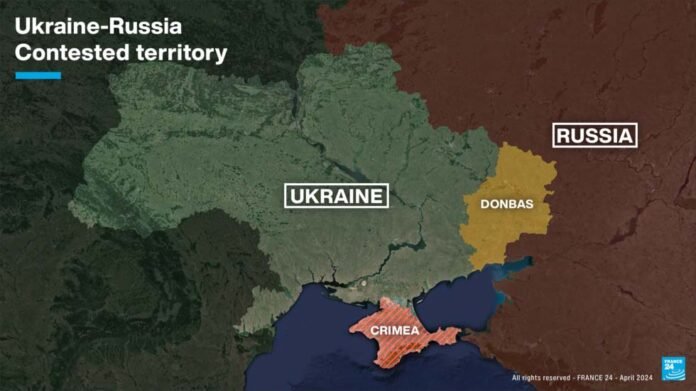As the war in Ukraine grinds through yet another scorching season, the territory of Donbas has again become the battleground between calm and endless conflict. The most recent peace talks, hype-filled Western conferences, and military drills all appear inevitably tangled up with the gruesome calculus that is being played day by day in Donetsk and Luhansk. These decisions made at gunpoint to the leaders in Kyiv, Moscow, Washington and Brussels are much more than the fate of a region but to the architecture of power in Europe for a generation.
Donbas Imbroglio: Lines Drawn and Redrawn
Russia’s demand is unflinching and unmistakable. The Kremlin insists that the entire Donbas, already majority occupied by Russian and proxy forces, must be surrendered before any credible ceasefire can happen. On Russian channels and international platforms, there is open talk of inevitable ‘military solutions’ to what Moscow frames as unfinished historical business. It is a primary goal entrenched by the continuous movement of troops witnessed in the past weeks. Based on battlefield reports and international observers, Russian forces are controlling an estimated 60% of Donbas, and are pushing further into the mineral-rich regions still occupied by Ukrainians. This is not Putin’s bargaining card, but a fundamental purpose fixed by constant troop relocation, as observed in the past weeks.
Ironclad resistance forms the core of the Ukrainian position. President Zelenskyy and his cabinet have repeatedly declared, both for domestic audiences and international partners, that they will “not give an inch” more. Their resolve is rooted in basic law: Ukraine’s constitution explicitly forbids ceding territory under external pressure. This is reinforced by a societal consensus that views every lost city as a threat to national identity and the state’s survival. With military fortunes see-sawing violently around cities such as Sloviansk and Lysychansk, and no doubt about Russian intentions in the remainder of the oblast, giving ground is not just a bad deal but an existential danger.
For Ukraine, giving ground is not just a bad deal but an existential danger. President Zelenskyy and his cabinet have repeatedly declared, both for domestic audiences and international partners, that they will “not give an inch” more. Their resolve is rooted in basic law: Ukraine’s constitution explicitly forbids ceding territory under external pressure
Western Powers at Cross-Purposes
If Ukraine and Russia appear locked in a grim embrace, the West’s position is even more ambiguous. European Union leaders publicly hammer home the need for an immediate ceasefire, imagining that peace talks can come only after the shooting stops. This posture, though deeply humanitarian, is seen in Moscow as at best naive and at worst a green light for temporary Russian consolidation before new offensives. The EU has floated offers ranging from post-war reconstruction aid to vague guarantees of long-term security, but the ambiguity of these positions has eroded confidence, both in Kyiv and in capitals further east. Reports suggest that Chancellor Merz of Germany, facing growing domestic exhaustion with war, has clashed with American counterparts on whether to press Ukraine into an interim freeze or await a fuller settlement.
Across the Atlantic, US leadership is divided but tilting towards expediency. The US administration, keenly aware of war fatigue at home and escalating global challenges elsewhere, supports an approach that would trade Donbas for a peace deal and wider security guarantees. Leaks from closed-door negotiations and summaries from allied diplomats reveal a growing impatience in Washington for a ‘closure’, with or without Ukrainian blessing. In most quarters, this has been translated to mean: accept the new lines, get Western aid, and stop the bloodshed, or the grim consequences that are likely to follow.
The power games emerged when senior American officials dismissed European appeals to declare an immediate ceasefire, the counterargument being that any ceasefire would not endure if it accepted Russian territorial gains. Internal splits have become a strategic liability, with Moscow’s negotiators gleefully playing Western capitals against each other.
A Shifting Military and Political Landscape
Few expect a diplomatic breakthrough unless the facts on the ground change decisively. Russian forces are reported to be preparing fresh offensives, seeking to occupy up to 80% of Donbas before freezing lines and demanding international recognition of their gains. Ukrainian defenders, meanwhile, are buoyed by new Western weapons shipments but stretched thin and deeply aware of the cost of attrition.
European Union leaders publicly hammer home the need for an immediate ceasefire, imagining that peace talks can come only after the shooting stops. This posture, though humanitarian, is seen in Moscow as at best naive and at worst a green light for temporary Russian consolidation before new offensives. The EU has floated offers ranging from post-war reconstruction aid
The latest round of talks has intensified the focus on Donbas as the war’s critical pivot. European observers note that, despite fierce debates over tactics, the continent’s willingness to offer security guarantees, without first expelling Russia from occupied territory, risks undermining both European and Ukrainian security. The spectre of an ‘imposed peace’ grows starker with every Russian breakthrough.
Scenarios for the Path Ahead
With both sides dug in, several scenarios now loom.
To start with, a compromise on terms dictated by Western pressure might result in Ukraine relenting to the ceasefire, when Russia will establish control over the bulk of Donbas. Such a result, already condemned in Kyiv as an unfair peace, would stir domestic sentiments against forced agreements and threaten to divide Ukrainian society along partisan and regional lines, leaving room for a new crisis in the future.
Second, if the EU and the US fail to cooperate, the process of the summit might reach an impasse, and Russia might go ahead in its embrace unopposed. US officials worry publicly that such discord only emboldens Moscow to extract greater concessions and to keep probing NATO’s red lines elsewhere.
Third, a hardening of positions could push the war into a new, more dangerous phase: Russia might escalate in Donbas and beyond, betting that the West’s resolve will ultimately fracture, while Ukraine, with ever more Western arms but dwindling public patience, takes higher risks to reverse the tide.
Finally, there are rumblings in European defence circles that, if American leadership wanes or ‘trades away’ the region, the EU must accelerate military integration and industrial expansion, perhaps even revisiting the prospect of independent nuclear deterrence. Analysts warn that such a rupture would transform NATO’s internal dynamics for a decade or more.
There are rumblings in European defence circles that, if American leadership wanes or ‘trades away’ the region, the EU must accelerate military integration and industrial expansion, perhaps even revisiting the prospect of independent nuclear deterrence. Analysts warn that such a rupture would transform NATO’s internal dynamics for a decade or more
Anxieties Beyond Donbas
These risks are not just theoretical. The consequences of a forced settlement in Donbas will be read in Beijing, Tehran, and far beyond as a sign of the Western world’s appetite for risk and solidarity. If territory can be acquired through brute force backed by nuclear blackmail, then the rules-based order that underpins both European and global security is in jeopardy.
Zelenskyy’s government, sensing the stakes, has moved visibly to shore up its alliances, seeking firmer statements from the EU and renewed commitments from the White House. Russian media frame the current phase as vindication for Moscow’s long game, insisting that Western fatigue and internal dissent guarantee victory for the Kremlin’s calculus.
The Stakes in the Weeks Ahead
Donbas is not only the battleground of destruction and mayhem, but a place where the future of Europe rests. As troops escalate and political deadlines are just about to be reached, an actual, just, and lasting peace that can serve as a keynote is further and further away.
Any future summit or course will not only seal the destiny of the Ukrainian peoples but will also shape the future of the West in the twenty-first century. The dilemma facing allied capitals is straightforward and austere: will peace in Donbas be purchased at the cost of principle, or will Europe and its allies demonstrate once more that aggression would not redefine borders with impunity?
That question will be answered in the next few months, and its implications will reverberate much further than the perforated ground of Donbas.
The author, a PVSM, AVSM, VSM has had an illustrious career spanning nearly four decades. A distinguished Armoured Corps officer, he has served in various prestigious staff and command appointments including Commander Independent Armoured Brigade, ADG PP, GOC Armoured Division and GOC Strike 1. The officer retired as DG Mechanised Forces in December 2017 during which he was the architect to initiate process for reintroduction of Light Tank and Chairman on the study on C5ISR for Indian Army. Subsequently he was Consultant MoD/OFB from 2018 to 2020. He is also a reputed defence analyst, a motivational speaker and prolific writer on matters of military, defence technology and national security. The views expressed are personal and do not necessarily carry the views of Raksha Anirveda






